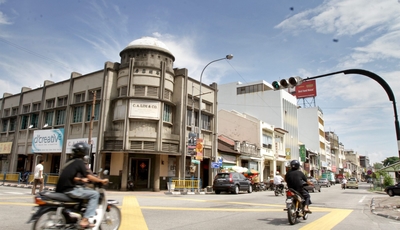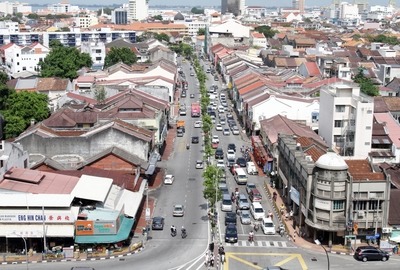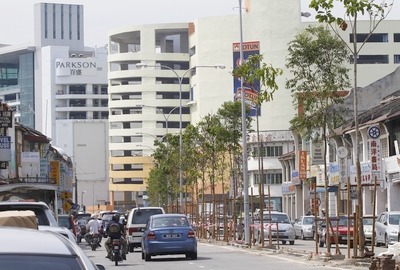 Still standing: Soo Beng building at Jalan Tun Dr Lim Chwee Leong and Carvarvon Street junction.
Still standing: Soo Beng building at Jalan Tun Dr Lim Chwee Leong and Carvarvon Street junction. LOOKING at the heavy flow of traffic along Jalan Dr Lim Chwee Leong and Carnarvon Street today, not many would recall it was once a huge swamp area with a canal where boats and junks could sail in.
Carnarvon Street — the street of undertakers, coffin-makers, joss stick shops and school textbook shops — has long been known to older Penangites as lam chan ngah, which means swampy rice fields, in the early days of Penang.
It was a marshland with a Malay settlement and the adjoining Carnarvon Lane was known as kam kong lai or Malay village.
The street was named after the 4th Earl of Carnarvon, Henry Herbert. He was the secretary of the State of Colonies, or simply the British official in charge of the colonies from 1866 to 1867.
The town and county of Carnarvon Street were located in the principality of Wales. He was also a prominent member of the Conservative Party.
Prangin Road — now renamed Jalan Dr Lim Chwee Leong — used to have a huge canal and until the 1940s, boats used to carry goods from the seafront all the way inland along the Prangin Canal.
The old market area, Prangin Market, was called Sia Boey or end of the town, by the Hokkiens. There were also vegetable farms in that area, where produce were uploaded on these boats.
When the Komtar building was being built, excavation works carried out in that area found evidence of coins, chinaware and other utensils, believed to have been thrown into the canal by Chinese sailors. Many of these historical items are now being stored at the state museum.
By the time I was a schoolboy, the Prangin Canal had turned into a big smelly drain. It used to be a bus stop for the privately-run Lim Seng Seng buses.
The bus operator was efficient but the conductors, including the women, were rude, tough and even nasty. They had no qualms about kicking out, literally, any student who attempted to shove his way into an overly crowded bus.
 Place of interest: Carnarvon Street is lined with pre-war houses.
Place of interest: Carnarvon Street is lined with pre-war houses. A few were sheer bullies — students not in uniform were charged the full fare and it was pointless to offer any explanation as to why we were not in uniform. Perhaps, they got commission from the sale of tickets, I suspected.
Waiting by the stinking canal or drain, no one told me it used to be a river which marked the borders of early 19th century George Town or that the name of the road had gone from Prangin River to Prangin Creek to Prangin Canal and then a huge drain.
According to Khoo Salma Nasution, early pictures showed bullock carts parked along the canal, which was lined with casuarinas, hence the Malay name then, pokok rhu.
Today, the drain is buried. But on reflection, the city fathers had lost an opportunity to transform the dirty canal into a lovely promenade in the city.
Instead, in the name of urban renewal, this became the site for the Komtar building. Hundreds of pre-war houses were demolished to make way for the 65-storey building, which began construction in 1974.
Today, the building, which houses mostly government offices with little interest from the private sector, looks like a sore thumb in the midst of the surviving heritage houses, which everyone wants to preserve and protect.
When the construction started, the museum officials called me and my colleague, Ronald Bryne, to have a look at the large number of coins and broken pieces of porcelain they found at the canal and its vicinity. It marked my earliest interest in the history of the canal.
 Green facelift: Carnarvon Street recently underwent a beautification project, which saw 60 trees planted along the road.
Green facelift: Carnarvon Street recently underwent a beautification project, which saw 60 trees planted along the road. Prangin Road is today known as Dr Lim Chwee Leong — the father of Chong Eu. Chwee Leong was just 22 years old when he graduated and decided to move from his hometown of Singapore to settle in Penang.
The paediatrician held several community positions, including being the president of the Hu Yew Seah and the Straits Chinese British Association.
He set up his clinic, known as the Soo Beng Dispensary, near the Prangin Market, and the heritage building still remains.
The website, www.penang-traveltips.com describes the building as built “in the art deco style of the 1920s and finished in Shanghai plaster”.
Chwee Leong was a brilliant medical student at the King Edward VII College in 1909. He was a top student and was awarded the Lim Boon Keng Medal when he graduated in 1913.
It is said that for a short period of time, he worked as assistant surgeon for the Government District Hospital before starting his own practice in 1914.
The dispensary he opened was named after Soo Beng, his native village in Fujian province in southern China.
The website said it was here that Chwee Leong set up the People’s Clinic dispensing free medicine to the poor, greatly endearing himself to the locals.
The Edinburgh-trained Chong Eu, in fact, practised at the dispensary in 1947 when he returned from China after helping in the reconstruction of post-war China.
It is well documented that as a young medical student in Scotland, the Gerakan founder and president was one of the members of the London-based United Kingdom and Eire Chinese Students’ Association, which actively rallied support for China’s fight against the Japanese occupation.
The area surrounding the Soo Beng building can be spruced up further as it sits on a prime commercial area.
Readers write
Reader Joseph Kay e-mailed to ask whether it is true that Anna Leonowens, played by Jodie Foster in the movie Anna and the King, is buried at the Protestant cemetery at Farquhar Street.
Chun Wai: The answer is no but her husband, Thomas Leonowens, is. According to known records on various websites, Leonowens was a young army officer who died of malaria at the age of 31, leaving Anna as a young widow. Penniless and jobless, Anna decided to travel to Thailand, then known as Siam, to be a teacher and subsequently wrote about her experience in the royal court. The memoir reportedly received scant attention but decades later became a popular book for schoolgirls. It became a Broadway hit before hitting the big screen as The King and I in 1946 with Yul Brynner in the lead. The version with Jodie Foster also starred Chow Yuen Fatt. It was filmed primarily in Malaysia, mainly in Ipoh, but with some street scenes in Penang. However, there is another version about the Leonowens based on a book published in 2008. According to author Susan Morgan in Bombay Anna: The Real Story and Remarkable Adventures of The King and I Governess, Thomas was actually a hotel keeper in Penang and had died of apoplexy.
Captain Francis Light, the founder of Penang, is also buried at the same cemetery. His trading partners, James Scott, David Brown and James Richardson Logan are also buried there. The famous Padang Brown at Datuk Keramat and Logan Road are named as such to commerorate the two men. Quintin Dick Thomas, the brother-in-law of Stamford Raffles, lies buried there as well. Raffles, who founded Singapore, worked briefly in Penang at the government house, now part of the Convent Light Street’s premises.
If you have queries on the streets of Penang, or your own stories, kindly email to mystory@thestar.com.my





